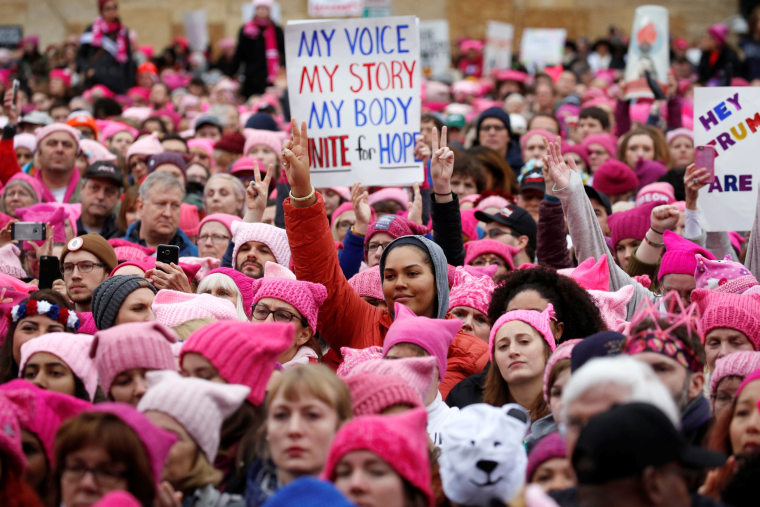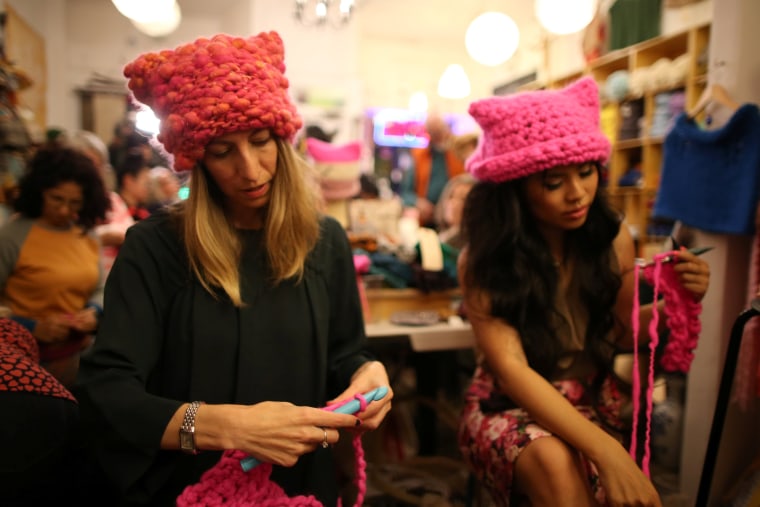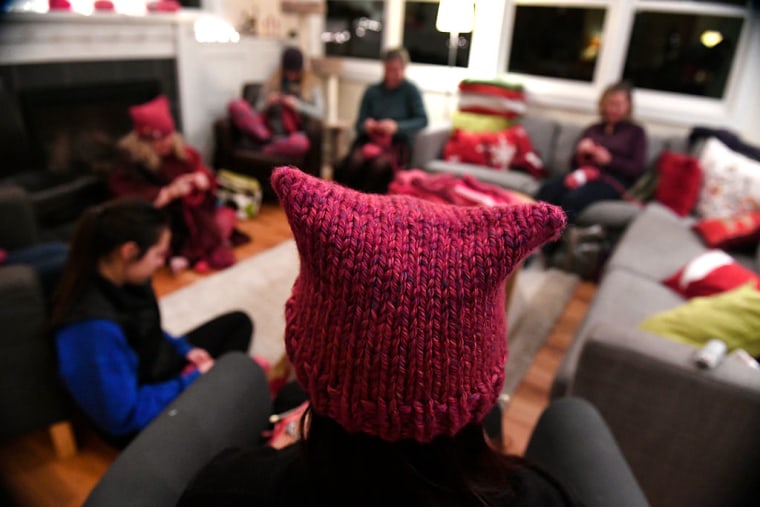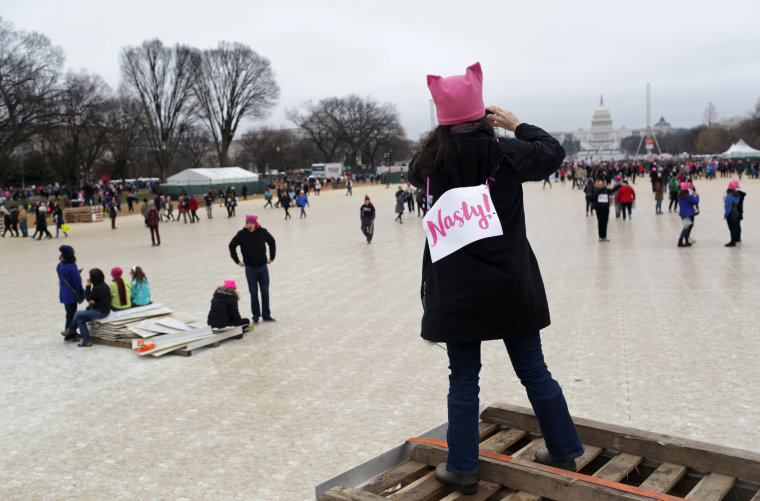(Editor's Note: This article contains slang that some may find offensive)
The cat-eared “pussyhat” became the crown of the Women’s March in January. Many saw it as a symbol of female empowerment -- and still don the pink hat weeks after the event that catapulted it to fame. But others believed the pussyhat equated gender with biology, making some transgender people feel excluded from the movement.
“I never thought that by calling it the ‘pussyhat’ that it was saying that women’s issues are predicated on the possession of the pussy,” Pussyhat Project co-founder Krista Suh told NBC Out.
Suh said that was not the knitting group’s intention when it created the hat. She expressed sadness that some people felt that way.

“I think ‘pussy’ refers to the female anatomical part, but it’s also a word that’s used to shame people who are feminine … whether they are men, women [or] genderqueer. And I think what it comes down to is that femininity is really disrespected in our society,” Suh explained.
The Los Angeles screenwriter said the concept was inspired by outrage over President Trump’s “grab 'em by the pussy” comment captured in a 2005 Access Hollywood recording. The symbolism is all about “pussy power,” she explained. She said the knitters were frustrated that the most intimate part of their bodies is often used as a catchword for weakness.
“We want to reclaim that word,” Suh said.
The Pussyhat Project created the do-it-yourself knitting pattern and put it online prior to the march. It spread rapidly across the internet. On January 21 — the day of the Women’s March — cat-eared protesters poured into cities worldwide to take a stand for women’s rights, leaving a sea of pink in their wake. In the days after, the knitters would see their hat on the cover of Time Magazine and The New Yorker. Suh felt amazed.
“It just showed how powerful the symbol has become,” she said.

But controversy exploded around the hat online. Aside from getting criticized over its reference to genitalia, the knitters were accused of excluding women of color. Some of the hat’s critics believed the its pinkness was a reference to flesh tone.
But the color has nothing to do with race, according to Suh, who is Asian American. She said the group chose pink because it is associated with femininity.
“My belief is that pink is considered a little bit frivolous, girly, weak, soft, effeminate, and honestly, I don’t think it’s the color, I think it’s a code for women,” Suh said. “And it doesn’t matter what people wear, if it’s a color associated with women, it will be mocked.”
By embracing pink, marchers sent a clear message: “We don’t care what you think,” Suh explained.
“[Women are] given all these crap chores and hoops to jump through, saying that [when you’ve done them], then we [society] will respect you,” Suh said. “I just don’t want to play that game anymore.”

The hat is a metaphor, not just for women who are cisgender (a person who identifies with their birth sex), but any person or group who can relate to feeling marginalized, according to the knitter.
“But I don’t want to shy away from the fact that it does refer to the female reproductive organ,” Suh said. “That’s a huge issue right now. How can women’s rights supporters of any gender… protect these literal reproductive parts from unfair legislation?”
Pussyhat: 'Dangerous' for Trans People?
Transgender professor Cael Keegan, who teaches women, gender and sexuality studies at Grand Valley State University in Michigan, is suspicious of the hat as a symbol.
“We know that any time feminism starts centering people based on anatomy, that gets kind of dangerous for trans people,” Keegan said.
Keegan believes transgender people, like cisgender women, are fighting for autonomy over their own bodies, but feels their issues are often seen as separate and less important. A federal judge in Texas temporarily halted protections for both trans and abortion-related health care services under the Affordable Care Act in December, and many government agencies require transgender people to undergo gender-affirming surgery to have the gender marker on their legal identification changed, Keegan noted. Not all transgender people desire to have surgery, according to advocates.
“If people were really paying attention to reproductive rights they would know that in many, many states in the U.S., transgender people are required to become sterilized to change our [legal] genders,” Keegan said.

Keegan said the pussyhat seems to send an unconscious message that only cisgender women experience sexual assault. But according to the Office for Victims of Crime, one in two transgender individuals have experienced this type of victimization.
“A lot of the reasons [transgender women] are attacked is because they do not possess that piece of anatomy,” Keegan explained.
Keegan said it can be difficult to talk about these issues. He said he quit a women’s studies listserv in January after some feminists sent emails arguing that reproductive issues only affect cisgender women. Keegan claimed one prominent feminist sent a hurtful email stating that “only women get pregnant and anyone who’s pretending otherwise is deluded.” He said he fears the pussyhat symbolism reinforces those notions.
'Language Policing' and 'Safe Spaces'
Transgender woman Elaine Rita Mendus, a 26-year-old writer from New York City, said she “absolutely understands the use of the pussyhat.”
“[President Donald Trump] has come out very strongly against reproductive rights and has targeted people with vaginas,” Mendus said. “Cisgender women especially they are targeted and transgender men are obviously caught in the shot as well, and they are the ones who have that sort of genitalia, and they’re the ones who are under attack at the moment.”
Mendus said she is more concerned about the real-life problems transgender people face, like high rates of homelessness, than the name of a hat.

“There are transgender people being murdered or living in the streets all over this country, constantly, and transgender women and cisgender women need to be together on that front,” Mendus said. “All people need to work together to try to deal with that rather than worrying about this language policing or making of safe spaces, quite frankly.”
Mendus, who said she has had trouble sleeping since the election, wants liberals to stop wasting time on “frivolous battles like pussyhats.”
“We need to work on dealing with the problems at hand, not a stupid hat,” Mendus said.
'Anatomy of All People'
Elle Hearns, a Black transgender activist and executive director of the Marsha P. Johnson Institute, said the hat’s popularization showed how some issues take precedent over others.
“The fact that this hat is on the cover of [Time Magazine and The New Yorker] at a time where immigrants and refugees are being held captive essentially and being forced to reconcile that they may never be able to return to the place they call home, just shows how out of alignment America is with the things that really matter,” Hearns said.
The former organizing director of Black Lives Matter said the hat’s symbolism is disrespectful of grassroots movements that have tried to create a progressive conversation around the “anatomy of all people.” She believes that in order for movements to be truly intersectional they must center around the most marginalized.
“Anything that is not elevating the conversation around the many identities of people in this country is not one that services the equality or the liberation or the freedom that people are pursuing,” she insisted.
People often find hope or value in a physical symbol like the pussyhat, Hearns acknowledged, but she is not one of them.
“The symbol that for me means the absolute most and means everything is freedom,” Hearns explained. “The hat won’t prove anything. The actions of the people will."

